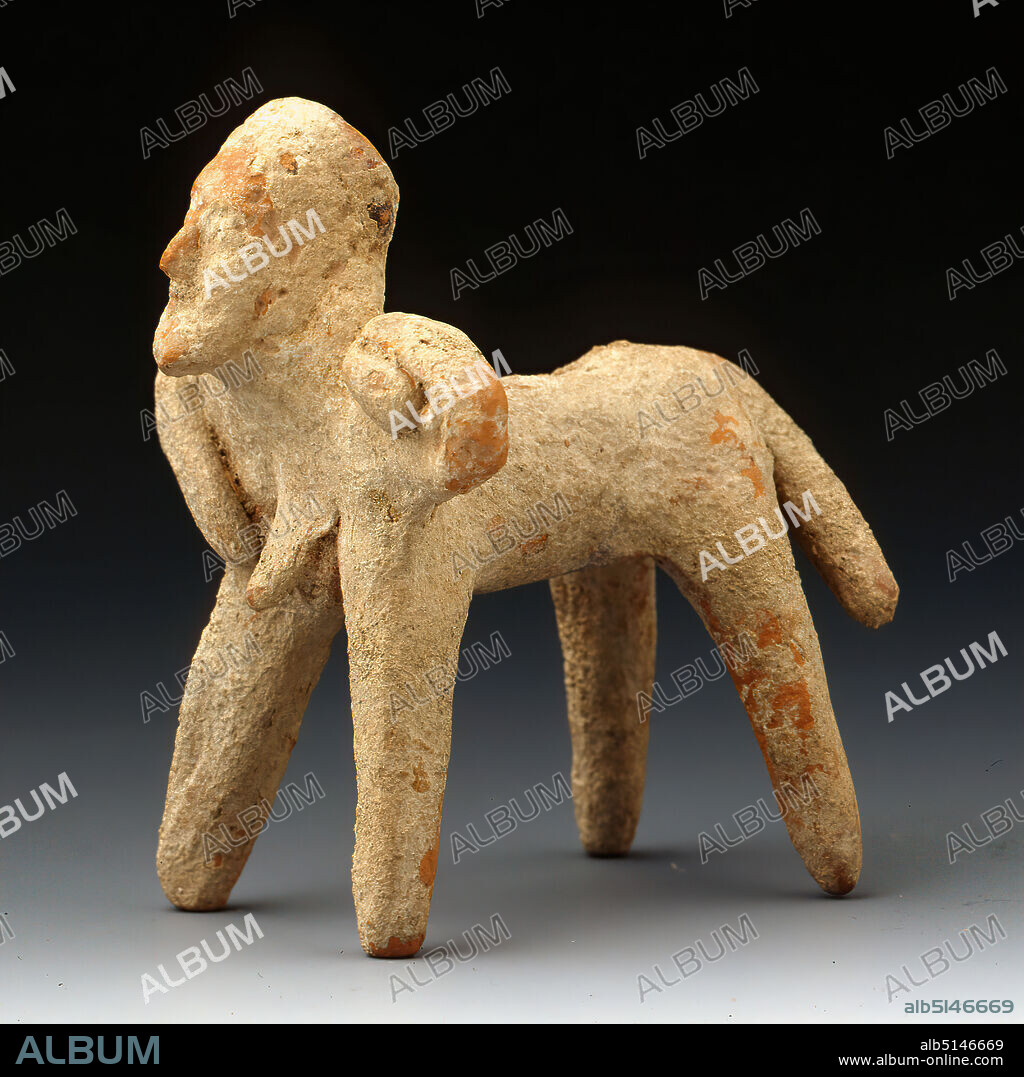alb5146669
Centaur, Gift from Gertrud Benndorf (Hamburg), Clay, hand-modeled, Clay, hand-modeled, Total: Height: 8.8 cm; Width: 5.5 cm; Depth: 8.2 cm, Ceramics, Small sculptures/small sculptures, Centaurs, late archaic, Greek antiquity, The centaur stands on the floor with its four slightly flared but not plastically modeled legs. The forelegs are part of a shortened male body with arms and genitals, which is followed by the horse's body with tail at the back. The hand of the left arm holds a ball on the shoulder, ready for throwing; the right arm hangs down. The bearded, easily to the back inclined head carries a bandage in the hair. Centaurs encounter Greek mythology in various legends: In Thessaly, they seize the bride at the wedding of Prince Peirithoos and try to rob the other women present. The ensuing battle symbolized the struggle between good and evil, and enjoyed great popularity in ancient art. In Arcadia, the story is told of Heracles' visit to the centaur Pholos and the following battle against his wild conspecifics. In another myth, Heracles killed the centaur Nessos, who had committed suicide against the wife of the hero. The oldest representation of a centaur comes from a grave in Lefkandi (Euboia Island) and is dated to the 10th century BC. This terracotta forms a group with technically very similar figures in Munich, Würzburg and Leipzig.

|
Añadir a otro lightbox |
|
Añadir a otro lightbox |



¿Ya tienes cuenta? Iniciar sesión
¿No tienes cuenta? Regístrate
Compra esta imagen.
Selecciona el uso:

Descripción:
Ver traducción automática
Centaur, Gift from Gertrud Benndorf (Hamburg), Clay, hand-modeled, Clay, hand-modeled, Total: Height: 8.8 cm; Width: 5.5 cm; Depth: 8.2 cm, Ceramics, Small sculptures/small sculptures, Centaurs, late archaic, Greek antiquity, The centaur stands on the floor with its four slightly flared but not plastically modeled legs. The forelegs are part of a shortened male body with arms and genitals, which is followed by the horse's body with tail at the back. The hand of the left arm holds a ball on the shoulder, ready for throwing; the right arm hangs down. The bearded, easily to the back inclined head carries a bandage in the hair. Centaurs encounter Greek mythology in various legends: In Thessaly, they seize the bride at the wedding of Prince Peirithoos and try to rob the other women present. The ensuing battle symbolized the struggle between good and evil, and enjoyed great popularity in ancient art. In Arcadia, the story is told of Heracles' visit to the centaur Pholos and the following battle against his wild conspecifics. In another myth, Heracles killed the centaur Nessos, who had committed suicide against the wife of the hero. The oldest representation of a centaur comes from a grave in Lefkandi (Euboia Island) and is dated to the 10th century BC. This terracotta forms a group with technically very similar figures in Munich, Würzburg and Leipzig.
Crédito:
Album / quintlox
Autorizaciones:
Tamaño imagen:
4320 x 4320 px | 53.4 MB
Tamaño impresión:
36.6 x 36.6 cm | 14.4 x 14.4 in (300 dpi)
Palabras clave:
ARCADIA • ARCILLA • ARTE ANTIGUO • BARBUDO • BEARDED • BODA • BOLA • BUENA • CABELLERA • CABELLO • CASAMIENTO • CENTAUR • CENTAURO • CERAMICA • CIFRAS • COLA (DE ANIMAL) • DIABLO • ESPOSA • FÁCILMENTE • FOLLOWED • GROUP • GRUPO • GRUPO. • HAIR • HAMBURGO • HEROE • HOMBRO • INCAUTAR • LEIPZIG • MANO • MANOS • MUNICH • NOVIA • PELO CABELLO • PELO • PROFUNDIDAD • PRUEBAS • RELATO • ROBAR • SUELO • TESALIA • TUMBA
 Pinterest
Pinterest Twitter
Twitter Facebook
Facebook Copiar enlace
Copiar enlace Email
Email
